QR code
Creative Arts Solution
FOUNDATION
a non-governmental foundationQR Code Generator | Create Your QR Code for Free

Visit: Ayibiowu Olusola David (Emmanuel)

Visit now: http://l.ead.me/bb1cHc
Connect with us on Socail Media
See also: Free Barcode Generator Online
QR code
The Quick Response (QR code) system became popular outside the automotive industry due to its fast readability and greater storage capacity compared to standard UPC barcodes. Applications include product tracking, item identification, time tracking, document management, and general marketing.[2]
A QR code consists of black squares arranged in a square grid on a white background, which can be read by an imaging device such as a camera, and processed using Reed–Solomon error correction until the image can be appropriately interpreted. The required data is then extracted from patterns that are present in both horizontal and vertical components of the image.[2]
History
The QR code system was invented in 1994 by the Japanese company Denso Wave. Its purpose was to track vehicles during manufacturing; it was designed to allow high-speed component scanning.[3] QR codes are now used in a much broader context, including both commercial tracking applications and convenience-oriented applications aimed at mobile-phone users (termed mobile tagging). QR codes may be used to display text to the user, to add a vCard contact to the user's device, to open a Uniform Resource Identifier (URI), to connect to a wireless network, or to compose an email or text message. There are a great many QR code generators available as software or as online tools.[4] The QR code has become one of the most-used types of two-dimensional code.[5]Standards
Structure of a QR code, highlighting functional elements
- October 1997 – AIM (Association for Automatic Identification and Mobility) International[7]
- January 1999 – JIS X 0510
- June 2000 – ISO/IEC 18004:2000 Information technology – Automatic identification and data capture techniques – Bar code symbology – QR code (now withdrawn)
Defines QR code models 1 and 2 symbols. - 1 September 2006 – ISO/IEC 18004:2006 Information technology – Automatic identification and data capture techniques – QR code 2005 bar code symbology specification (now withdrawn)[8]
Defines QR code 2005 symbols, an extension of QR code model 2. Does not specify how to read QR code model 1 symbols, or require this for compliance. - 1 February 2015 – ISO/IEC 18004:2015 Information – Automatic identification and data capture techniques – QR Code barcode symbology specification
Renames the QR Code 2005 symbol to QR Code and adds clarification to some procedures and minor corrections.
Uses
A QR code used on a large billboard in Japan, linking to the sagasou.mobi website
QR codes have become common in consumer advertising. Typically, a smartphone is used as a QR code scanner, displaying the code and converting it to some useful form (such as a standard URL for a website, thereby obviating the need for a user to type it into a web browser). QR code has become a focus of advertising strategy, since it provides a way to access a brand's website more quickly than by manually entering a URL.[11][12] Beyond mere convenience to the consumer, the importance of this capability is that it increases the conversion rate: the chance that contact with the advertisement will convert to a sale. It coaxes interested prospects further down the conversion funnel with little delay or effort, bringing the viewer to the advertiser's website immediately, where a longer and more targeted sales pitch may lose the viewer's interest.
Although initially used to track parts in vehicle manufacturing, QR codes are used over a much wider range of applications. These include commercial tracking, entertainment and transport ticketing, product and loyalty marketing and in-store product labeling. Examples of marketing include where a company's discounted and percent discount can be captured using a QR code decoder which is a mobile app, or storing a company's information such as address and related information alongside its alpha-numeric text data as can be seen in Yellow Pages directory.
They can also be used in storing personal information for use by organizations. An example of this is Philippines National Bureau of Investigation (NBI) where NBI clearances now come with a QR code. Many of these applications target mobile-phone users (via mobile tagging). Users may receive text, add a vCard contact to their device, open a URI, or compose an e-mail or text message after scanning QR codes. They can generate and print their own QR codes for others to scan and use by visiting one of several pay or free QR code-generating sites or apps. Google had an API, now deprecated, to generate QR codes,[13] and apps for scanning QR codes can be found on nearly all smartphone devices.[14]
QR codes have been incorporated into currency. In June 2011 The Royal Dutch Mint (Koninklijke Nederlandse Munt) issued the world's first official coin with a QR code to celebrate the centenary of its current building and premises. The coin can be scanned by a smartphone and link to a special website with contents about the historical event and design of the coin.[19] In 2014 the Central Bank of Nigeria issued a 100-naira banknote to commemorate its centennial, the first banknote to incorporate a QR code in its design. When scanned with an internet-enabled mobile device, the code goes to a website which tells the centenary story of Nigeria.[20] In 2015, the Central Bank of the Russian Federation issued a 100-rubles note to commemorate the annexation of Crimea by the Russian Federation. It contains a QR code into its design, and when scanned with an internet-enabled mobile device, the code goes to a website that details the historical and technical background of the commemorative note. In 2017, the Bank of Ghana issued a 5-cedis banknote to commemorate 60 years of Central Banking in Ghana, and contains a QR code in its design, which when scanned with an internet-enabled mobile device, that code goes to the official Bank of Ghana website.
Credit card functionality is under development. On February 20, 2016, the Reserve Bank of India (RBI) will[needs update] launch the eponymously named Bharat QR, a common QR code jointly developed by all the four major card payment companies - National Payments Corporation of India that runs RuPay cards along with MasterCard, Visa and American Express. It will also have the capability of accepting payments on the unified payments interface (UPI) platform.[21][22]
Mobile operating systems
QR codes can be used on various mobile device operating systems. These devices support URL redirection, which allows QR codes to send metadata to existing applications on the device. Many paid or free apps are available with the ability to scan the codes and hard-link to an external URL.URLs
URLs aided marketing conversion rates even in the pre-smartphone era, but during those years faced several limitations: ad viewers usually had to type the URL and often did not have a web browser in front of them when they first viewed the ad. The chances were high that they would forget to visit the site later, not bother to type a URL, or forget what URL to type. Semantic URLs decreased these risks but did not eliminate them. Some of these disadvantages to URL conversion rates are fading away now that smartphones are putting web access and voice recognition within constant reach, with QR codes redirecting to URLs for instant access.Virtual stores
During the month of June 2011, according to one study, 14 million mobile users scanned a QR code or a barcode. Some 58% of those users scanned a QR or barcode from their homes, while 39% scanned from retail stores; 53% of the 14 million users were men between the ages of 18 and 34.[23] The use of QR codes for "virtual store" formats started in South Korea,[24] and Argentina,[25] but is currently expanding globally.[26] Walmart, Procter & Gamble and Woolworths have already adopted the Virtual Store concept.[27]QR code payment
QR codes can be used to store bank account information or credit card information, or they can be specifically designed to work with particular payment provider applications. There are several trial applications of QR code payments across the world.[28][29] In developing countries like India and China, QR code payment is a very popular and convenient method of making payments.[30][31]In November 2012, QR code payments were deployed on a larger scale in the Czech Republic when an open format for payment information exchange — a Short Payment Descriptor — was introduced and endorsed by the Czech Banking Association as the official local solution for QR payments.[32] In 2013, the European Payment Council provided guidelines for the EPC QR code enabling SCT initiation within the Eurozone.
QR codes are commonly used in the field of cryptographic currencies, particularly those based on and including Bitcoin.[33] Payment addresses, cryptographic keys and transaction information are often shared between digital wallets in this way.[34]
Website login
QR codes can be used to log into websites: a QR code is shown on the login page on a computer screen, and when a registered user scans it with a verified smartphone, they will automatically be logged in. Authentication is performed by the smartphone which contacts the server. Google tested such a login method in January 2012.[35]WiFi network login
By specifying the SSID, encryption type, password/passphrase, and if the SSID is hidden or not, mobile device users can quickly scan and join networks without having to manually enter the data.[36] Note that this technique is valid for specifying only static SSID passwords (i.e. PSK); dynamic user credentials (i.e. Enterprise/802.1x) cannot be encoded in this manner.The format of the encoded string is:
WIFI:S:<SSID>;T:<WPA|WEP|>;P:<password>;H:<true|false|>;Order of fields does not matter. Special characters """ (quotation mark), ";" (semicolon), "," (comma) and ":" (colon) should be escaped with a backslash ("\") as in MECARD encoding. For example, if an SSID were
"foo;bar\baz", with quotation marks part of the literal SSID name itself, this would be encoded as: WIFI:S:\"foo\;bar\\baz\";;[37]
As of January 2018, iPhones have this feature built into the camera app under iOS 11.x. Android users may have the feature built into one of the device's stock apps (e.g. Samsung Galaxy S8/S8+/Note8 users can launch the stock browser, tap the browser's 3-dot menu, then choose "Scan QR code") or can install one of several available free apps such as "Barcode Scanner" or "QR Droid" to perform the QR Wi-Fi join.
Funerary use
In 2008, Ishinokoe in Yamanashi Prefecture, Japan began to sell tombstones with QR codes produced by IT DeSign, where the code leads to a virtual grave site of the deceased.[38][39][40] Other companies, such as Wisconsin based Interactive Headstones, have begun implementing QR codes into tombstones.[41] In 2014 the Jewish Cemetery of La Paz in Uruguay began implementing QR codes for tombstones.[42]TOTP use
QR codes are also used in scanning TOTP secrets to generate time based one time passwords.Encryption
Japanese immigration landing permission with a QR code at the bottom. The QR code content is encrypted.
The Japanese immigration system usage of encrypted QR codes on landing permission stamps in passports, is another example.[45][46]
Video games
Popular video games, such as Fez, The Talos Principle, and Watch Dogs, have incorporated QR codes as story and/or gameplay elements.[47][48]Design
Unlike the older, one-dimensional barcodes that were designed to be mechanically scanned by a narrow beam of light, a QR code is detected by a 2-dimensional digital image sensor and then digitally analyzed by a programmed processor. The processor locates the three distinctive squares at the corners of the QR code image, using a smaller square (or multiple squares) near the fourth corner to normalize the image for size, orientation, and angle of viewing. The small dots throughout the QR code are then converted to binary numbers and validated with an error-correcting algorithm.Storage
The amount of data that can be stored in the QR code symbol depends on the datatype (mode, or input character set), version (1, …, 40, indicating the overall dimensions of the symbol, i.e. 4 × version number + 17 dots on each side), and error correction level. The maximum storage capacities occur for version 40 and error correction level L (low), denoted by 40-L:[5][49]| Input mode | Max. characters | Bits/char. | Possible characters, default encoding |
|---|---|---|---|
| Numeric only | 7,089 | 3⅓ | 0, 1, 2, 3, 4, 5, 6, 7, 8, 9 |
| Alphanumeric | 4,296 | 5½ | 0–9, A–Z (upper-case only), space, $, %, *, +, -, ., /, : |
| Binary/byte | 2,953 | 8 | ISO 8859-1 |
| Kanji/kana | 1,817 | 13 | Shift JIS X 0208 |
Error correction
Damaged but still decodable QR code, Link to http://en.m.wikipedia.org
Example of a QR code with artistic embellishment that will still scan correctly thanks to error correction
| Level L (Low) | 7% of codewords can be restored. |
| Level M (Medium) | 15% of codewords can be restored. |
| Level Q (Quartile)[50] | 25% of codewords can be restored. |
| Level H (High) | 30% of codewords can be restored. |
Due to error correction, it is possible to create artistic QR codes that still scan correctly, but contain intentional errors to make them more readable or attractive to the human eye, as well as to incorporate colors, logos, and other features into the QR code block.[51][52]
It is also possible to design artistic QR codes without reducing the error correction capacity by manipulating the underlying mathematical constructs.[53][54]
Encoding
The format information records two things: the error correction level and the mask pattern used for the symbol. Masking is used to break up patterns in the data area that might confuse a scanner, such as large blank areas or misleading features that look like the locator marks. The mask patterns are defined on a grid that is repeated as necessary to cover the whole symbol. Modules corresponding to the dark areas of the mask are inverted. The format information is protected from errors with a BCH code, and two complete copies are included in each QR symbol.[2]The message dataset is placed from right to left in a zigzag pattern, as shown below. In larger symbols, this is complicated by the presence of the alignment patterns and the use of multiple interleaved error-correction blocks.
| Mode indicator | Description | Typical structure '[ type : sizes in bits ]' |
|---|---|---|
| 0001 | Numeric | [0001 : 4] [ Character Count Indicator : variable ] [ Data Bit Stream : 10 × charcount ] |
| 0010 | Alphanumeric | [0010 : 4] [ Character Count Indicator : variable ] [ Data Bit Stream : 11 × charcount ] |
| 0100 | Byte encoding | [0100 : 4] [ Character Count Indicator : variable ] [ Data Bit Stream : 8 × charcount ] |
| 1000 | Kanji encoding | [1000 : 4] [ Character Count Indicator : variable ] [ Data Bit Stream : 13 × charcount ] |
| 0011 | Structured append | [0011 : 4] [ Symbol Position : 4 ] [ Total Symbols: 4 ] [ Parity : 8 ] |
| 0111 | ECI | [0111 : 4] [ ECI Assignment number : variable ] |
| 0101 | FNC1 in first position | [0101 : 4] [ Numeric/Alphanumeric/Byte/Kanji payload : variable ] |
| 1001 | FNC1 in second position | [1001 : 4] [ Application Indicator : 8 ] [ Numeric/Alphanumeric/Byte/Kanji payload : variable ] |
| 0000 | End of message | [0000 : 4] |
- Note:
- Character Count Indicator depends on how many modules are in a QR code (Symbol Version).
- ECI Assignment number Size:
- 8 × 1 bits if ECI Assignement Bitstream starts with '0'
- 8 × 2 bits if ECI Assignement Bitstream starts with '10'
- 8 × 3 bits if ECI Assignement Bitstream starts with '110'
| Indicator | Meaning |
|---|---|
| 0001 | Numeric encoding (10 bits per 3 digits) |
| 0010 | Alphanumeric encoding (11 bits per 2 characters) |
| 0100 | Byte encoding (8 bits per character) |
| 1000 | Kanji encoding (13 bits per character) |
| 0011 | Structured append (used to split a message across multiple QR symbols) |
| 0111 | Extended Channel Interpretation (select alternate character set or encoding) |
| 0101 | FNC1 in first position (see Code 128 for more information) |
| 1001 | FNC1 in second position |
| 0000 | End of message (Terminator) |
[ Mode Indicator][ Mode bitstream ] --> [ Mode Indicator][ Mode bitstream ] --> etc... --> [ 0000 End of message (Terminator) ]
| Encoding | Ver. 1–9 | 10–26 | 27–40 |
|---|---|---|---|
| Numeric | 10 | 12 | 14 |
| Alphanumeric | 9 | 11 | 13 |
| Byte | 8 | 16 | 16 |
| Kanji | 8 | 10 | 12 |
- V = 45 × C1 + C2
| Code | Character | Code | Character | Code | Character | Code | Character | Code | Character |
|---|---|---|---|---|---|---|---|---|---|
| 00 | 0 | 09 | 9 | 18 | I | 27 | R | 36 | Space |
| 01 | 1 | 10 | A | 19 | J | 28 | S | 37 | $ |
| 02 | 2 | 11 | B | 20 | K | 29 | T | 38 | % |
| 03 | 3 | 12 | C | 21 | L | 30 | U | 39 | * |
| 04 | 4 | 13 | D | 22 | M | 31 | V | 40 | + |
| 05 | 5 | 14 | E | 23 | N | 32 | W | 41 | – |
| 06 | 6 | 15 | F | 24 | O | 33 | X | 42 | . |
| 07 | 7 | 16 | G | 25 | P | 34 | Y | 43 | / |
| 08 | 8 | 17 | H | 26 | Q | 35 | Z | 44 | : |
Decoding example
The following images offer more information about the QR code.Variants
Micro QR code
Micro QR code is a smaller version of the QR code standard for applications where symbol size is limited. There are four different versions (sizes) of Micro QR codes: the smallest is 11×11 modules; the largest can hold 35 numeric characters.[56]IQR code
IQR Code is an alternative to existing QR codes developed by Denso Wave. IQR codes can be created in square or rectangular formations; this is intended for situations where a rectangular barcode would otherwise be more appropriate, such as cylindrical objects. IQR codes can fit the same amount of information in 30% less space. There are 61 versions of square IQR codes, and 15 versions of rectangular codes. For squares, the minimum size is 9x9 modules; rectangles have a minimum of 19x5 modules. IQR codes add error correction level S, which allows for 50% error correction.[57] IQR Codes have not yet been given an ISO specification, and only proprietary Denso Wave products can create or read IQR codes.[58]SQRC
Secure Quick Response code (SQRC) is a type of QR code that contains a "private data" segment after the terminator instead of the specified filler bytes "ec 11".[59] This private data segment must be deciphered with an encryption key. This can be used to store private information and to manage company's internal information.[60]Frame QR
FrameQR is a QR code with a “canvas area” that can be flexibly used. In the center of this code is the canvas area, where graphics, letters, and more can be flexibly arranged, making it possible to lay out the code without losing the design of illustrations, photos, etc.[61]Model 1 QR code is an older version of the specification. It is visually similar to the widely seen model 2 codes, but lacks alignment patterns.
License
The use of QR code technology is freely licensed as long as users follow the standards for QR Code documented with JIS or ISO. Non-standardized codes may require special licensing.[62]Denso Wave owns a number of patents on QR code technology, but has chosen to exercise them in a limited fashion.[62] In order to promote widespread usage of the technology Denso Wave chose to waive its rights to a key patent in its possession for standardized codes only.[6] In the USA, the granted QR code patent is US 5726435, and in Japan JP 2938338. The European Patent Office granted patent "EPO 0672994". to Denso Wave, which was then validated into French, UK, and German patents, all of which expired in March 2015.[63]
The text QR Code itself is a registered trademark and wordmark of Denso Wave Incorporated.[64] In UK, the trademark is registered as E921775, the word "QR Code", with a filing date of 03/09/1998.[65] The UK version of the trademark is based on the Kabushiki Kaisha Denso (DENSO CORPORATION) trademark, filed as Trademark 000921775, the word "QR Code", on 03/09/1998 and registered on 6/12/1999 with the European Union OHIM (Office for Harmonization in the Internal Market).[66] The U.S. Trademark for the word "QR Code" is Trademark 2435991 and was filed on 29 September 1998 with an amended registration date of 13 March 2001, assigned to Denso Corporation.[67]
Risks
The only context in which common QR codes can carry executable data is the URL data type. These URLs may host JavaScript code, which can be used to exploit vulnerabilities in applications on the host system, such as the reader, the web browser or the image viewer, since a reader will typically send the data to the application associated with the data type used by the QR code.In the case of no software exploits, malicious QR codes combined with a permissive reader can still put a computer's contents and user's privacy at risk. This practice is known as "attagging", a portmanteau of "attack tagging".[68] They are easily created and can be affixed over legitimate QR codes.[69] On a smartphone, the reader's permissions may allow use of the camera, full Internet access, read/write contact data, GPS, read browser history, read/write local storage, and global system changes.[70][71][72]
Risks include linking to dangerous web sites with browser exploits, enabling the microphone/camera/GPS, and then streaming those feeds to a remote server, analysis of sensitive data (passwords, files, contacts, transactions),[73] and sending email/SMS/IM messages or DDOS packets as part of a botnet, corrupting privacy settings, stealing identity,[74] and even containing malicious logic themselves such as JavaScript[75] or a virus.[76][77] These actions could occur in the background while the user is only seeing the reader opening a seemingly harmless web page.[78] In Russia, a malicious QR code caused phones that scanned it to send premium texts at a fee of US$6 each.[68]
Extension
Samples of the High Capacity Colored 2-Dimensional (HCC2D) code: (a) 4-color HCC2D code and (b) 8-color HCC2D code.
Introducing colors into QR codes requires addressing additional issues. In particular, during QR code reading only the brightness information is taken into account, while HCC2D codes have to cope with chromatic distortions during the decoding phase. In order to ensure adaptation to chromatic distortions which arise in each scanned code, HCC2D codes make use of an additional field: the Color Palette Pattern. This is because color cells of a Color Palette Pattern are supposed to be distorted in the same way as color cells of the Encoding Region. Replicated color palettes are used for training machine learning classifiers.
Reference:
Wikipedia



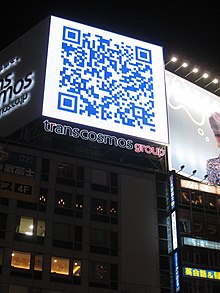
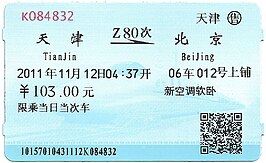

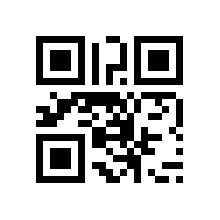


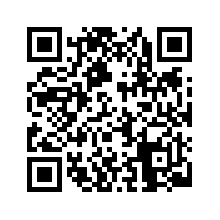
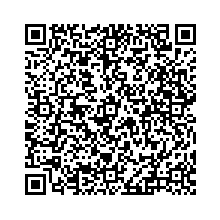
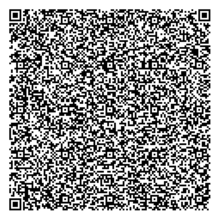
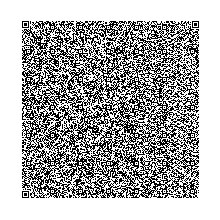
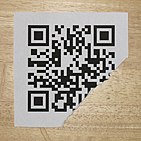

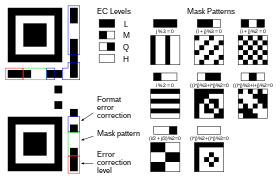




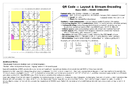



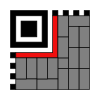

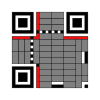


Comments
Post a Comment